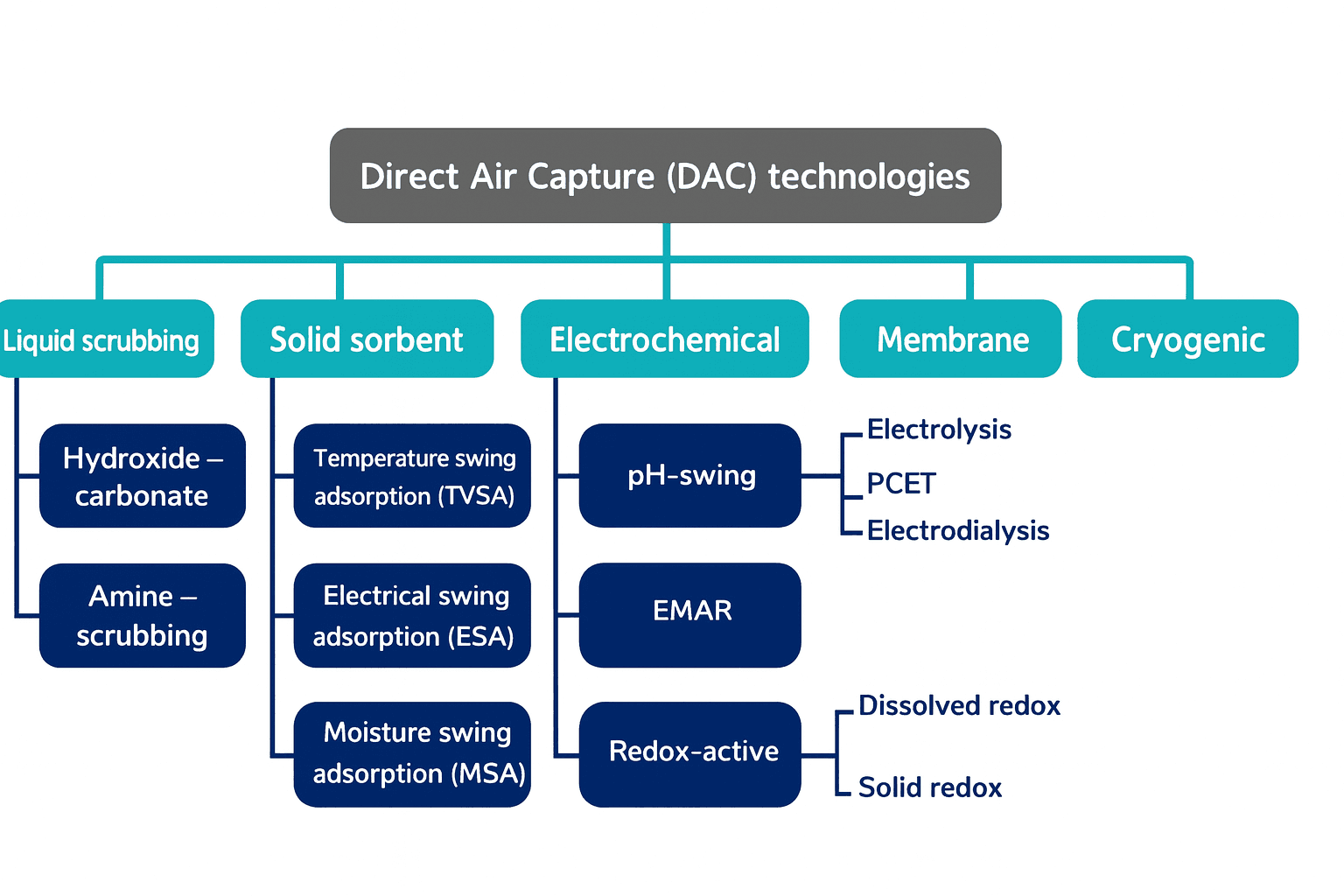What is Direct Air Capture?
Direct Air Capture (DAC) is a technology that uses chemical processes to extract carbon dioxide (CO₂) from the air to fight climate change caused by CO₂ emissions, and to reach net-zero and beyond to carbon negativity.
A DAC system works by using fans to draw in large quantities of air and passing it over solid sorbent materials that have been designed to attract and hold CO₂ molecules on their surfaces in chemical bonding. Alternatively, liquid solvents are used instead of solid sorbents.
Other forms of DAC include Electrochemical DAC and Cryogenic DAC. Have a look at DAC Technologies for a more detailed breakdown of the various Direct Air Capture technologies.
 Image source: Chemical Engineering Journal 484 (2024)
Image source: Chemical Engineering Journal 484 (2024)
The CO₂ is then extracted from the sorbent material or solvent and either permanently stored underground using various methods, such as mineralisation, or used practically in carbon utilization processes, for example in producing sustainable aviation fuel (SAF), storing CO₂ in concrete for sustainable construction, or in the food and beverage industry.
For more detail on DAC, see: How Does Direct Air Capture Work?
Why Do We Need Direct Air Capture?
The world is heating up
This heating up of the Earth has largely been caused by polluting emissions, with CO₂ being the main culprit.
We have to face the alarming fact that the earth has now reached the 1.5-degrees Celsius global warming threshold – a critical benchmark set by the scientific community and ratified by the Paris Agreement in 2015. This is the temperature that the world’s average surface temperature has increased by since the start of industrialisation, and in 2024, the EU’s climate service announced that global warming exceeded 1.5 degrees Celsius across an entire year.
Emissions reduction is not enough to reach net-zero
Concentration of CO₂ in the atmosphere is now at 420 parts per million (ppm) , and it needs to get down to 350 ppm to ward off climate change disaster. Although reducing carbon emissions is a fundamental part of tackling climate change, this will not be enough. We must remove the legacy CO₂ that is already in our atmosphere, and technologies such as Direct Air Capture have the potential to make a significant difference. For more detail, read here about Why Direct Air Capture.
Direct Air Capture is proving to be effective at removing CO₂ from the air, but there are also other technologies for carbon dioxide removal. Have a look here for more on the various carbon dioxide removal technologies.
The Challenges Facing Direct Air Capture
Direct Air Capture is not without its challenges. The most pressing of these are the costs and energy requirements.
As DAC technology advances, the costs are coming down. Initially, removing carbon dioxide from the air using direct air capture has been around $1000 per tonne of CO₂ but that figure can be brought as low as $100-$200 per tonne with the right technology in place.
Since the process of removing the CO₂ is energy intensive, renewable energy is a must, such as geothermal, solar or wind energy. DAC systems can be built in any suitable location (they don’t have to be close to the source of emissions) and therefore they can be set up close to sources of renewable energy. Furthermore, solid sorbent DAC is perfectly suited to make use of low-grade waste heat from industrial processes, which can reduce the electricity consumption by 70%.
For DAC to be effective in removing the amount of carbon from the air that is needed to reach net-zero by 2050, it will need to be deployed at scale, which will require dedicated investment and political will.
Conclusion
A recent Intergovernmental Panel on Climate Change (IPCC) report highlights the role that Direct Air Capture (DAC) will have in limiting warming to 1.5 °C. It estimates that DAC will be required to remove up to 310 billion tonnes of CO2 from the atmosphere between now and 2100. This will require committed investment into DAC technology.
For Direct Air Capture to be a successful part of the broader strategy to mitigate climate change, it requires innovation, investment and support.
For more:
- How Does Direct Air Capture Work?
- Why Removing CO2 from the Atmosphere is Urgent
- Direct Air Capture Cost Compared to Cost of Inaction on Climate Change
- The Advantages of Direct Air Capture

